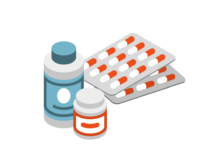By: Rayhan A. Tariq; Rishik Vashisht; Ankur Sinha; Yevgeniya Scherbak
Published in NCBI
November 17, 2020
Introduction
Close to 6,800 prescription medications and countless over-the-counter drugs are available in the United States. To further complicate a practitioner’s responsibility during patient care, there are thousands of health supplements, herbs, potions, and lotions used by the public regularly to treat their health problems. With the number of substances on the market, it is conceivable that mistakes can be made when practitioners prescribe or dispense drugs. Added to this is the high risk of interaction between substances.
Each year, in the United States alone, 7,000 to 9,000 people die due to a medication error. Additionally, hundreds of thousands of other patients experience but often do not report an adverse reaction or other complications related to a medication. The total cost of looking after patients with medication-associated errors exceeds $40 billion each year, with over 7 million patients affected. In addition to the monetary cost, patients experience psychological and physical pain and suffering as a result of medication errors. Finally, a major consequence of medication errors is that it leads to decreased patients satisfaction and a growing lack of trust in the healthcare system.[1][2]
The most common reasons for errors include failure to communicate drug orders, illegible handwriting, wrong drug selection chosen from a drop-down menu, confusion over similarly named drugs, confusion over similar packaging between products, or errors involving dosing units or weight. Medication errors may be due to human errors, but it often results from a flawed system with inadequate backup to detect mistakes.[3][4]
Medication Error
While there is no uniform definition of a medication error, The National Coordinating Council for Medication Error Reporting and Prevention defines a medication error as: “… any preventable event that may cause or lead to inappropriate medication use or patient harm while the medication is in the control of the healthcare professional, patient, or consumer. Such events may be related to professional practice, health care products, procedures, and systems, including prescribing; order communication; product labeling, packaging, and nomenclature; compounding; dispensing; distribution; administration; education; monitoring; and use.” However, there is no widely accepted uniform definition. Unfortunately, untoward medical errors and underreported medication errors result in significant morbidity and mortality. In order of frequency: medication errors, motor vehicle accidents, breast cancer, AIDS, and medication errors. Consider that two of the most common causes of death are related to healthcare-related events.[4][3][5][6]
Function
Medication errors can occur at many steps in patient care, from ordering the medication to the time when the patient is administered the drug. In general, medication errors usually occur at one of these points:
- Ordering/prescribing
- Documenting
- Transcribing
- Dispensing
- Administering
- Monitoring
Medication errors are most common at the ordering or prescribing stage. Typical errors include the healthcare provider writing the wrong medication, wrong route or dose, or the wrong frequency. These ordering errors account for almost 50% of medication errors. Data show that nurses and pharmacists identify anywhere from 30% to 70% of medication-ordering errors. It is obvious that medication errors are a pervasive problem, but the problem is preventable in most cases.[19]
Source: https://www.ncbi.nlm.nih.gov/books/NBK519065/
Image: https://nurseslabs.com/wp-content/uploads/2017/04/FB-Medication-Error-What-To-DO.jpg
Comment:
I selected this article as the information provided addresses one side of the issue which simply is the produced medication bottles. In addition to the responsibly of the health care physicians and patients, mediation bottles that indicate wrong information can initiate negative reactions upon consumption. Such mistakes are made by human-error with no additional help to detect any mistakes or inaccuracies prior to continuing production. At various stages such mistakes will occur which then, as mentioned, will challenge the responsibility of those prescribing and those consuming. As a result, patients health is placed into jeopardy which can heighten one’s condition or lead to even worse effects.





It’s interesting to see how much goes into the medication prescription process, and where errors can arise along the way. I think the article points out a big problem…the medical system is not double-checking to see if they “gave us the right order.” While this may fly at a fast-food restaurant, it cannot fly in healthcare. I do feel for the medical professionals though because they have so much on their plate already. It is human to make mistakes.